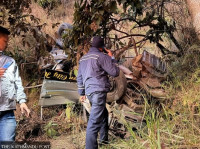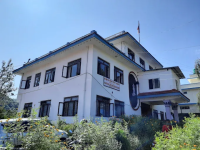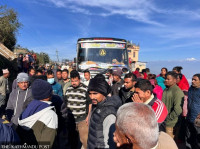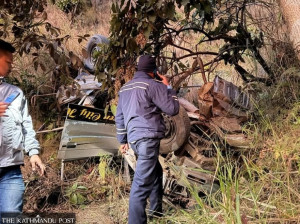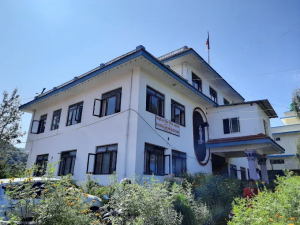Bagmati Province
Unregulated quarrying fuels fear in flood-ravaged Bethanchok
Despite a July landslide triggered by reckless mining, illegal and dangerous excavation near homes, a school and health post continues in Kavrepalanchok.
Jyoti Shrestha
Nine months after last year’s devastating monsoon-induced disasters, residents of Chalal Ganeshsthan in ward 4 of Bethanchok Rural Municipality remain gripped by fear. With the onset of the rainy season, they now face a dual threat—not only from natural disasters but also from unchecked mining activities near their settlements.
On July 10, a dry landslide struck the Ganeshsthan Mineral Plant site, intensifying anxiety among locals still recovering from last year's destruction. Unlike natural landslides, this one was human-induced, caused by improper excavation practices. Locals report that operators are cutting into the hillsides from below rather than digging from the top down, a method known to trigger slope instability.
One of the owners of the mine admitted to the practice, saying it is cheaper and less labour-intensive. “Excavating from the top increases labour and resource costs. So we opted to cut from below,” he said. That cost-cutting strategy, however, has endangered the settlement which is also at the risk of floods and landslides.
Gyan Prasad Timilsina, an engineer of Bethanchok Rural Municipality, confirmed that the method used by the mine violates safety protocols. “Excavation must proceed from the top, maintaining a slope and clearing debris systematically,” he said. “Otherwise, the site becomes hazardous to both workers and nearby residents.” Though the recent landslide caused no injuries or property damage, it has heightened the community’s sense of vulnerability.
According to the existing legal standards, crusher plants and quarries must be located at least 500 metres from rivers, roads and bridges, and two kilometres from schools, hospitals, religious and cultural sites and densely populated areas. The Ganeshsthan mine, however, is situated dangerously close to a school, a health post, a ward office and tightly clustered homes.
“We don't know the exact regulations. But operating a crusher plant right next to our homes is clearly unsafe,” said Ram Bahadur Tamang, a resident of Chalal Ganeshsthan. According to him, he cannot sleep well when it starts raining.
Fifty-year-old Sunmaya Tamang of Chalal Dobhan echoed the same concerns. “We’re already under threat from monsoon rains. Now, the dust and debris from the mine are choking the river. We worry it might flood our fields—or worse, our homes.” Her memories of last year’s flood, which submerged her house, are still fresh.
People of Kavrepalanchok, a hill district in Bagmati province, are still traumatised by the floods and landslides that struck in the last week of September 2024. Kavrepalanchok was the worst-hit district by the floods and landslides that struck various parts of the country. A total of 78 people were killed in the district, and the disasters destroyed various infrastructures, including houses, roads, community buildings, drinking water projects, and utility poles. Locals blame the haphazard extraction of stones and pebbles by crusher plants as a major cause of the devastating floods and landslides in Kavrepalanchok.
The locals of Bethanchok have been living in abject fear since last year’s disasters. They have been restless with the onset of monsoon season. Even mine beneficiaries in ward 4 of Bethanchok Rural Municipality are not immune to the fear. Sher Bahadur Tamang, 67, lives beside the Ramkrishna Construction Services quarry, which operates on his own land. Though he earns Rs2,000 per truckload of extracted material, he admits to being worried. “When it rains, I am concerned about landslides and flooding from the adjacent stream,” he said.
Bethanchok has three registered quarries and one crusher in operation. A meeting held on July 17 between local authorities and mining operators attempted to address the chaos. Issues like dust management, parking of mining vehicles, registration and royalty payments were discussed. The local government issued written instructions, demanding compliance with national guidelines.
Bhagawan Adhikari, chairman of Bethanchok Rural Municipality, said the local government has repeatedly ordered the quarries to follow standards, but enforcement remains weak.
Dipak Gautam, head of the District Coordination Committee, confirmed that operations are supposed to begin only after geological assessments. “We’ve already shut down non-compliant quarries in Panauti. Bethanchok was issued a one-week ultimatum,” he said.
Despite being officially declared high-risk zones by the federal government, many quarries in disaster-prone areas continue to operate without proper environmental or geological evaluations.
A recent district-level meeting chaired by Gautam noted that landslides and shifting river courses have placed entire settlements at risk. Dust and debris have also raised riverbed levels, further increasing flood dangers. The meeting resolved to request a comprehensive study from the National Disaster Risk Reduction and Management Authority (NDRRMA) covering settlements, rivers, forests, and mining zones.
Chief District Officer Umesh Kumar Dhakal confirmed that multiple requests have been made to NDRRMA for a geological and environmental expert team, especially since many recent disasters are tied to unregulated mining and riverbed disruption. “The river flow has changed course, putting communities in danger. The riverbeds have risen due to dust and debris,” he said. “Despite our repeated calls, no expert group has arrived yet.”
As monsoon rains continue in the region, residents of Bethanchok wait anxiously, caught between nature’s fury and human negligence.




 5.14°C Kathmandu
5.14°C Kathmandu
